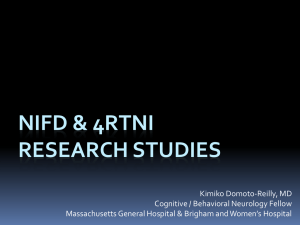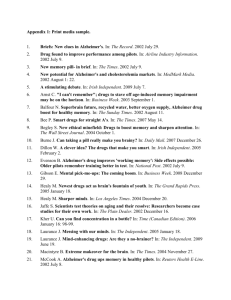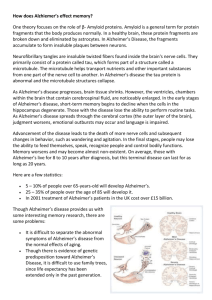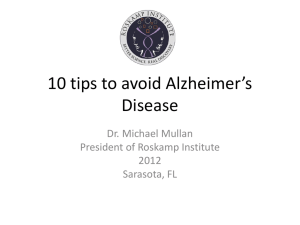Molecular_Psychiatry_07212014-3
advertisement
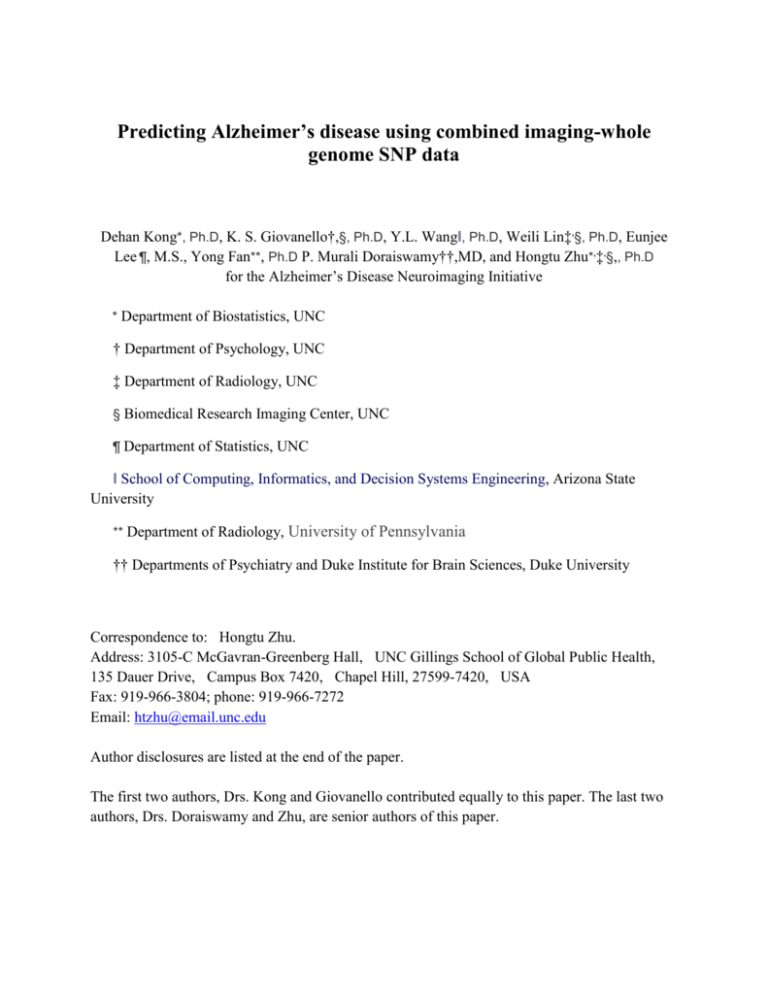
Predicting Alzheimer’s disease using combined imaging-whole genome SNP data Dehan Kong*, Ph.D, K. S. Giovanello†,§, Ph.D, Y.L. Wang‖, Ph.D, Weili Lin‡,§, Ph.D, Eunjee Lee ¶, M.S., Yong Fan**, Ph.D P. Murali Doraiswamy††,MD, and Hongtu Zhu*,‡,§,, Ph.D for the Alzheimer’s Disease Neuroimaging Initiative * Department of Biostatistics, UNC † Department of Psychology, UNC ‡ Department of Radiology, UNC § Biomedical Research Imaging Center, UNC ¶ Department of Statistics, UNC ‖ School of Computing, Informatics, and Decision Systems Engineering, Arizona State University ** Department of Radiology, University of Pennsylvania †† Departments of Psychiatry and Duke Institute for Brain Sciences, Duke University Correspondence to: Hongtu Zhu. Address: 3105-C McGavran-Greenberg Hall, UNC Gillings School of Global Public Health, 135 Dauer Drive, Campus Box 7420, Chapel Hill, 27599-7420, USA Fax: 919-966-3804; phone: 919-966-7272 Email: htzhu@email.unc.edu Author disclosures are listed at the end of the paper. The first two authors, Drs. Kong and Giovanello contributed equally to this paper. The last two authors, Drs. Doraiswamy and Zhu, are senior authors of this paper. ABSTRACT The growing public threat of Alzheimer’s disease (AD) has raised the urgency to discover and validate prognostic biomarkers. No prior study, to our knowledge, has examined the predictive value of whole genome SNP (from all 23 chromosomes) data either alone or in combination with high resolution whole brain MR data. In 343 subjects with mild cognitive impairment (MCI) enrolled in the Alzheimer’s Disease Neuroimaging Initiative (ADNI-1), we extracted high dimensional MR imaging (volumetric data on 93 brain regions plus a surface fluid registration based hippocampal subregion and surface data), genetic (504,095 SNPs from GWAS), neurocognitive and clinical data at baseline. MCI patients were followed over 48 months, with 150 participants progressing to AD. Cox regression model and functional principal component analysis were used to compare the predictive value of combined imaging-genetic markers versus standard clinical-cognitive markers. Receiver operating characteristic (ROC) analysis revealed that the model combining just routine clinical and cognitive data with a single genotype (ApoE4) had a low predictive value at 48 months (AUC 0.75). In contrast, the model combining full genetic SNP and imaging data (but without any cognitive data) had a much higher predictive value (AUC 0.95). SNPS on chromosomes 2, 10, 11, 15, 17 and 18 as well as volumes of hippocampus, amygdala and thalamus contributed significantly. Our findings are the first demonstration of the value of combined whole brain MR and whole genome SNP data in the 48month prognosis of subjects at risk for AD. Keywords: Alzheimer , hippocampal surface, mild cognitive impairment, receiver operating characteristic, whole genome. Introduction The growing public threat of Alzheimer’s disease (AD) has raised the urgency to discover and validate prognostic biomarkers that may identify subjects at greatest risk for future cognitive decline and accelerate the testing of preventive strategies.1,2 In this regard, studies of combinatorial biomarkers may have greater ability to capture the heterogeneity and multifactorial complexity of AD, than a traditional single biomarker study.3 Prior studies of subjects at risk for AD have examined the utility of various individual biomarkers, such as cognitive tests, fluid markers, imaging measures and some individual genetic markers (e.g. ApoE4).1 In particular, imaging markers such as hippocampal volume and shape, cortical regional volumes and thickness, and PET (amyloid imaging, FDG) abnormalities have all been linked in one or more studies to faster progression in at risk subjects,4-16 but are not yet optimally predictive at an individual level. More recently, genome-wide association study (GWAS) data has been used to characterize several potential genetic risk factors for AD with several cross-sectional studies also correlating these data with imaging and fluid biomarkers.17 However, no prior study, to our knowledge, has leveraged both GWAS SNP data, as well as high dimensional whole brain imaging data to examine their combined value in identifying subjects at greatest risk for progressing to AD. Materials and Methods Alzheimer’s Disease Neuroimaging Initiative Data used in the preparation of this article were obtained from the Alzheimer’s Disease Neuroimaging Initiative (ADNI) database (www.loni.usc.edu/ADNI). The ADNI was launched in 2003 by the National Institute on Aging (NIA), the National Institute of Biomedical Imaging and Bioengineering (NIBIB), the Food and Drug Administration (FDA), private pharmaceutical companies and non-profit organizations, as a $60 million, 5-year public private partnership. The primary goal of ADNI has been to test whether serial magnetic resonance imaging (MRI), positron emission tomography (PET), other biological markers, and clinical and neuropsychological assessment can be combined to measure the progression of mild cognitive impairment (aMCI) and early Alzheimer’s disease (AD). Determination of sensitive and specific markers of very early AD progression is intended to aid researchers and clinicians to develop new treatments and monitor their effectiveness, as well as lessen the time and cost of clinical trials. The Principal Investigator of this initiative is Michael W. Weiner, M.D., VA Medical Center and University of California - San Francisco. ADNI is the result of efforts of many coinvestigators from a broad range of academic institutions and private corporations, and subjects have been recruited from over 50 sites across the U.S. and Canada. The initial goal of ADNI was to recruit 800 adults, ages 55 to 90, to participate in the research – approximately 200 cognitively normal older individuals to be followed for 3 years, 400 people with aMCI to be followed for 3 years, and 200 people with early AD to be followed for 2 years. For up-to-date information see www.adni-info.org. Data Description For each subject, the radial distance was obtained from baseline hippocampal surfaces data, which yields two 15000 dimensional vectors denoting data from left hippocampus and right hippocampus, respectively. We treated them as realizations of two functional predictors. Next, we applied functional principal component analysis (FPCA), see Rice and Silverman (1991) and Ramsay and Silverman (2005) for examples. It turns out that we select 7 functional principal component (FPC) scores for each predictor, which explain approximately 70% of the variance. For implementation of FPCA, we use the “svd” function in R software. Besides the hippocampal surface data, we included several clinical and genetic covariates: Gender (1=Male; 2=Female), Handedness (1=Right; 2=Left), Marital Status (1=Married; 2=Widowed; 3=Divorced; 4=Never married), Education length, Retirement (1=Yes; 0=No), and Age. Since Marital Status has four levels, we included three dummy variables. We also included the APOE4 genotype, which has two alleles, as studies have shown that the APOE4 genotypes have significant effect in MCI. The first allele has three genotypes: 2, 3, 4, thus we included two dummy variables for this allele. The second allele has only two genotypes: 3 and 4, so one dummy variable was needed. We also include the ADAS-Cog score, which is a composite score of 11 questions to reflect the severity of AD. In addition, we selected ROIs among the 93 ROI volume data from the Jacob atlas.21 We chose 23 ROIs which may significantly influence MCI progression.10,22,23 The 23 ROIs were bilateral entorhinal cortices, bilateral hippocampal formation, bilateral amygdala, bilateral caudate nuclei, bilateral putamen, bilateral posterior limb of internal capsule including cerebral peduncle, bilateral nucleus accumbens, bilateral lateral ventricles, bilateral thalamus, bilateral fornix, bilateral cingulate and the corpus callosum. Finally, we included information from all the 22 chromosomes. Since each chromosome contains a number of SNPs, we used principal component analysis for each chromosome and picked the first 2 principal components for each chromosome. We then used the PLINK package ( http://pngu.mgh.harvard.edu/~purcell/plink/data.shtml#plink) to perform the principal component analysis for each chromosome. => We then used the PLINK package ( http://pngu.mgh.harvard.edu/~purcell/plink/data.shtml#plink) to perform quality control for the genomic data. The principal component analysis for each chromosome was conducted using “svd” function in R software. Hippocampus Image Preprocessing We adopted a surface fluid registration based hippocampal subregional analysis package,24 which uses isothermal coordinates and fluid registration to generate one-to-one hippocampal surface registration for following surface statistics computation. This software package has been adopted by various studies.25-30 Given the 3D MRI scans, hippocampal substructures were segmented with FIRST31 and hippocampal surfaces were automatically reconstructed with the marching cube method32. We applied an automatic algorithm, topology optimization, to introduce two cuts on a hippocampal surface to convert it into a genus zero surface with two open boundaries. The locations of the two cuts were at the front and back of the hippocampal surface, representing its anterior junction with the amygdala, and its posterior limit as it turns into the white matter of the fornix. Then holomorphic 1-form basis functions were computed.33 These induced conformal grids the hippocampal surfaces which were consistent across subjects. With this conformal grid, we computed the conformal representation of the surface,24 i.e., the conformal factor and mean curvature, which represent the intrinsic and extrinsic features of the surface, respectively. The “feature image” of a surface was computed by combining the conformal factor and mean curvature and linearly scaling the dynamic range into [0, 255]. Next, we registered the feature image of each surface in the dataset to a common template with an inverse consistent fluid registration algorithm.26 With conformal parameterization, we essentially converted a 3D surface registration problem into a 2D image registration problem. The flow induced in the parameter domain establishes high-order correspondences between 3D surfaces. Finally, various surface statistics were computed on the registered surface, such as multivariate tensor-based morphometry (mTBM) statistics,33 which retain the full tensor information of the deformation Jacobian matrix, together with the radial distance,34 which retains information on the deformation along the surface normal direction. The SNP data The subjects’ genotype variables were acquired based on the Human 610-Quad Bead- Chip (Illumina, Inc., San Diego, CA) in the ADNI database, which resulted in 620,901 SNPs. To reduce the population stratification effect, we used 749 Caucasians from all 818 subjects with complete imaging measurements at baseline. Quality control procedures included (i) call rate check per subject and per SNP marker, (ii) gender check, (iii) sibling pair identification, (iv) the Hardy-Weinberg equilibrium test, (v) marker removal by the minor allele frequency, and (vi) population stratification. The second line preprocessing steps include removal of SNPs with (a) more than 5% missing values, (b) minor allele frequency smaller than 5% , and (c) HardyWeinberg equilibrium p-value < 1e−6. Remaining missing genotype variables were imputed as the modal value. Seven hundred forty seven subjects and 504,095 SNPs remained. Statistical Approach A popular model used in literature is the Cox proportional hazards model (Cox, 1972), which accounts for other covariates that are associated with the timing of the events. Covariates of interest include demographic information (8 covariates), the APOE4 genotype (3 covariates), the ADAS-Cog score (1 covariate), the hippocampus surface data (7 covariates for each curve, total 14 covariates), the ROI volume data (23 covariates), and the chromosome information (2 covariates for each chromosome, total 44 covariates). We used the R function “coxph” to implement the fitting of the Cox proportional hazards model. We fitted a Cox regression model with demographic, clinical and cognitive (ADAS-Cog score) predictors as well as APOE, referred to as the Clinical-Cognitive model (Model 1) from here on, and obtained its estimation and testing results. This model did not include any other Imaging or GWAS data. We fitted a second Cox regression model with demographic, Imaging and GWAS predictors, but without the ADAS-Cog score, referred to as the Imaging-Genetics model (Model 2) from here on, and obtained its estimation and testing results. We treated the left and right hippocampus surface data, as well as the SNP data on all 23 chromosomes, as functional predictors. We used FPCA to extract the first seven FPCs of each of the left and right hippocampus surface data and the first two FPCs of the SNP data along each chromosome, then used theses as basis functions to represent the regression coefficient functions associated with the hippocampus surface and SNP on all chromosomes in the Cox regression. As an illustration, we plotted the first seven FPCs for both left and right hippocampi in Figure 1. Conversion: Conversion to dementia was determined according to standardized ADNI criteria by the clinicians at each site using all available clinical and cognitive information. Among the 343 individuals, 150 MCIs progressed to AD before study completion and the remaining 193 MCIs did not convert to AD prior to study end. MCI converters differed from MCI nonconverters with respect the APOE 4 genotype and the ADAS-Cog 11 score. Results In 343 subjects with mild cognitive impairment (MCI) enrolled in the Alzheimer’s Disease Neuroimaging Initiative (ADNI-1), we extracted high dimensional MR imaging (volumetric data on 93 brain regions plus a surface fluid registration based hippocampal subregion and surface data), and whole genome data (504,095 SNPs from GWAS), as well as routine neurocognitive and clinical data at baseline. MCI patients were then followed over 48 months, with 150 participants progressing to AD (Online Methods Table 1). MCI converters did not differ from MCI noncoverters in gender, handedness, marital status, retirement percentage, and age (p-values>0.05), but as expected, differed from them in APOE4 status as well as baseline cognition (p-value<0.05) (Table 1). Mean follow up time was 75 days longer in converters (p=0.06). Statistical analyses employed a combination of Cox proportional hazard models, receiving operating characteristic (ROC) methods, and functional principal component analysis (fPCA) that predict the time of conversion, as well as determine the significant predictors that have effects on the time to conversion. More specifically, Cox models were used to compute the association between the hazard rate of the conversion along time (i.e., MCI conversion to AD) and multimodal predictors (i.e., hippocampal surface area, genotype, and clinical covariates). For the imaging data, we included both ROI volumes, as well as hippocampus surface morphology, the latter of which adds additional predicative value. For the genetic data, since each chromosome contains a number of SNPs, we used principal component analysis for each chromosome and picked the first 2 principal components for each chromosome. We then used the PLINK package ( http://pngu.mgh.harvard.edu/~purcell/plink/data.shtml#plink) to perform the principal component analysis for each chromosome. => We then used the PLINK package ( http://pngu.mgh.harvard.edu/~purcell/plink/data.shtml#plink) to perform quality control for the genomic data. The principal component analysis for each chromosome was conducted using “svd” function in R software. We compared the predictive value of standard of care (clinical demographic variables, APOE4, the ADAS-Cog score, Model 1) versus imaging-genetic markers (MRI volumes and surface data plus GWAS SNP and demographics, Model 2). Receiver operating characteristic (ROC) analysis revealed that Model 1 (combining just routine clinical demographics and cognitive data with a single genotype ApoE4) had a low predictive value at 48 months (AUC 0.75) (Supplemental Table 1, Supplemental Figure 3). In this model, ApoE4 and ADAS-Cog were the significant predictors. In contrast, Model 2 (combining full genetic SNP and high dimension imaging data with demographics but without any cognitive data) had a much higher predictive value (AUC 0.95) (Figure 2, Supplemental Table 2, Supplemental Figure 3). SNPS on chromosome 2, 10, 11, 15, 17 and 18 (Supplemental Figure 2), ApoE4 status, surface morphology data of both hippocampi (especially anterior regions, Figure 1, Supplemental Figure 1) and volumes of hippocampus, amygdala and thalamus contributed significantly. 100-fold cross validation using a test and training data set revealed AUC of 0.95 (+/-0.014) for the imaging-genetic model and 0.75 (+/-0.024) for the clinicalcognitive model. Combining all variables (cognitive data plus imaging-genetic data) showed high predictive accuracy (AUC 0.96) but was not different from the value provided by imaginggenetics data alone. Discussion and Conclusions These findings are the first demonstration, to our knowledge, of the value of combined whole brain MR and whole genome SNP data in the 48-month prognosis of subjects at risk for AD. Our finding support prior MRI studies of volumetric hippocampal changes in prodromal AD8,18 and extend them by finding that the possible prognostic value of combining information from high dimensional imaging and genetics may be superior to that provided by routine clinicalcognitive testing data. Our findings also confirm the association between APOE4 status and AD, and identify additional new markers on chromosomes 2, 10, 11, 15, 17 and 18 as having significant effects on conversion. A variety of genes have been identified in prior GWAS studies as potential risk factors for AD such as clusterin (chromosome 8), complement receptor 1 (chromosome 1), phosphatidylinositol binding clathrin assembly protein (chromosome 11), sortilin-related receptor (chromosome 11), triggering receptor expressed on myeloid cells 2 (chromosome 6) and cluster of differentiation 33 (chromosome 19) as well as TOMM40 (chromosome 19).19 Our study did not examine any of these newer gene markers specifically but provides support to the notion that there is additional genetic heritability in late-onset AD beyond that accounted for by APOE. There are some strengths and limitations to our analyses. ADNI is a national biomarker study that utilized rigorous standardized data collection procedures, and well established criteria to select MCI subjects. Rather than using the individual data on all SNPs, we used the more conservative statistical method of doing principal component analysis for each chromosome and picking the first 2 principal components for each chromosome. Our findings survived internal cross validation but need replication in an independent community based sample. We did not include measures of pathology (e.g. beta-amyloid) in our models since CSF and amyloid-PET were available only in a small subset of individuals in ADNI-1. However, a study of ADNI-2 subjects has shown a robust correlation between the APOE e4 ε4 allele and cortical amyloid burden,20 suggesting that APOE e4 may have served as a surrogate for cortical amyloid plaque load in our analysis. Prior investigations of prediction of MCI-AD to AD have utilized feature selection to assess the most important biomarkers of prediction of conversion. Here, we have demonstrated the utility of Cox hazard models as a valuable method for identifying the “optimal combination” of early markers of conversion to AD in patients with MCI. If replicated in independent cohorts, such combinatorial markers of early AD could be useful for selecting at risk individuals for prevention trials and for discovering novel targets for discovering disease modifying therapies. CONFLICT OF INTEREST The authors declare no conflict of interest. ACKNOWLEDGEMENTS This work was supported in part by NlH grants RR025747-01, P01CA142538-01, MH086633, and AG033387 to Dr. Zhu. The content is solely the responsibility of the authors and does not necessarily represent the official views of the NIH. Data used in preparation of this article were obtained from the Alzheimer’s Disease Neuroimaging Initiative (ADNI) database (adni.loni.usc.edu). As such, the investigators within the ADNI contributed to the design and implementation of ADNI and/or provided data but did not participate in analysis or writing of this report. A complete listing of ADNI investigators can be found at: http://adni.loni.usc.edu/wpcontent/uploads/how_to_apply/ADNI_Acknowledgement_List.pdf Data collection and sharing for this project was funded by the Alzheimer's Disease Neuroimaging Initiative (ADNI) (National Institutes of Health Grant U01 AG024904) and DOD ADNI (Department of Defense award number W81XWH-12-2-0012). ADNI is funded by the National Institute on Aging, the National Institute of Biomedical Imaging and Bioengineering, and through generous contributions from the following: Alzheimer’s Association; Alzheimer’s Drug Discovery Foundation; BioClinica, Inc.; Biogen Idec Inc.; Bristol-Myers Squibb Company; Eisai Inc.; Elan Pharmaceuticals, Inc.; Eli Lilly and Company; F. Hoffmann-La Roche Ltd and its affiliated company Genentech, Inc.; GE Healthcare; Innogenetics, N.V.; IXICO Ltd.; Janssen Alzheimer Immunotherapy Research & Development, LLC.; Johnson & Johnson Pharmaceutical Research & Development LLC.; Medpace, Inc.; Merck & Co., Inc.; Meso Scale Diagnostics, LLC.; NeuroRx Research; Novartis Pharmaceuticals Corporation; Pfizer Inc.; Piramal Imaging; Servier; Synarc Inc.; and Takeda Pharmaceutical Company. The Canadian Institutes of Health Research is providing funds to support ADNI clinical sites in Canada. Private sector contributions are facilitated by the Foundation for the National Institutes of Health (www.fnih.org). The grantee organization is the Northern California Institute for Research and Education, and the study is coordinated by the Alzheimer's Disease Cooperative Study at the University of California, San Diego. ADNI data are disseminated by the Laboratory for Neuro Imaging at the University of Southern California. PMD has received research grants and/or advisory fees from several government agencies, advocacy groups and pharmaceutical/imaging companies. PMD received a grant from ADNI to support data collection for this study and he owns stock in Sonexa, Maxwell, Adverse Events and Clarimedix, whose products are not discussed here. Supplementary information is available at Molecular Psychiatry’s website REFERENCES 1. Michael W. Weiner, Dallas P. Veitcha, Paul S. Aisen, Laurel A. Beckett, Nigel J. Cairnsh, Robert C. Green, Danielle Harvey, Clifford R. Jack, William Jagust, Enchi Liu, John C. Morris, Ronald C. Petersen, Andrew J. Saykino, Mark E. Schmidt, Leslie Shaw, Judith A. Siuciak, Holly Soares, Arthur W. Toga, & John Q. Trojanowski; Alzheimer’s Disease Neuroimaging Initiative. (2012). The Alzheimer’s Disease Neuroimaging Initiative: A review of papers published since its inception. Alzheimers Dement.8, S1-S68. 2. Doraiswamy, P.M., Sperling, R.A., Johnson, K, Reiman, E.M., Wong ,T.Z., Sabbagh, M.N., Sadowsky, C.H., Fleisher, A.S., Carpenter, A, Joshi, A.D., Lu, M, Grundman, M, Mintun, M.A., Skovronsky, D.M., & Pontecorvo, M.J.; AV45-A11 Study Group. (2014) Florbetapir F 18 amyloid PET and 36-month cognitive decline:a prospective multicenter study. Mol Psychiatry, In Press. 3. Atluri G, Padmanabhan K, Fang G, Steinbach M, Petrella JR, Lim K, Macdonald A 3rd, Samatova NF, Doraiswamy PM, Kumar V. (2013) Complex biomarker discovery in neuroimaging data: Finding a needle in a haystack. Neuroimage Clin. 3:123-131. 4. Costafreda, S.G., Dinov, I.D., Tu, Z., Shi, Y., Liu, C.Y., Kloszewska, I., Mecocci, P., Soininen, H., Tsolaki, M., Vellas, B., Wahlund, L.O., Spenger, C., Toga, A.W., Lovestone, S., & Simmons, A. (2011) Automated hippocampal shape analysis predicts the onset of dementia in mild cognitive impairment. Neuroimage. 56, 212-9. 5. Cui, Y., Liu, B., Luo, S., Zhen, X., Fan, M., Liu, T., Zhu, W., Park. M., Jiang, T., & Jin, S.E. (2011) Identification of conversion from Mild Cognitive Impairment to Alzheimer’s disease using multivariate predictors. PLoS One 6, e21896. 6. Cuingnet, R., Gerardin, E., Tessieras, J., Auzias, G., Lehericy, S., Habert, M.O., Chupin, M., Benali, H., & Colliot, O. Automatic classification of patients with Alzheimer's disease from structural MRI: a comparison of ten methods using the ADNI database. (2011) Neuroimage 56, 766-81. 7. Davatzikos, C., Bhatt, P., Shaw, L.M., Batmanghelich, K.N., & Trojanowski, J.Q. Prediction of MCI to AD conversion, via MRI, CSF biomarkers, and pattern classification. (2011) Neurobiol Aging 32, 2322.e19-2322.e27. 8. Dickerson, B.C. & Wolk., D. A., Alzheimer's Disease Neuroimaging Initiative. Biomarkerbased prediction of progression in MCI: comparison of AD signature and hippocampal volume with spinal fluid amyloid-β and tau. (2013) Front Aging Neurosci. 5, 1-9. 9. Eckerström C, Olsson E, Bjerke M, Malmgren H, Edman A, Wallin A, & Nordlund A. A combination of neuropsychological, neuroimaging, and cerebrospinal fluid markers predicts conversion from mild cognitive impairment to dementia. (2013) J Alzheimers Dis. 36, 421-31. 10. Jack, C. R. Jr., Petersen, R. C., Xu, Y. C., et al Prediction of AD with MRI-based hippocampal volume in mild cognitive impairment. (1999) Neurology 52, 1397-1403. 11. Qiu A., Fennema-Notestine, C., Dale, A.M., & Miller, M.I. (2009) Regional shape abnormalities in mild cognitive impairment and Alzheimer’s disease. Neuroimage 45,656-661. 12. Querbes, O., Aubry, F., Pariente, J., Lotterie, J.A., Demonet, J.F., Duret, V., Puel, M., Berry, I., Fort, J.C. & Celsis, P. (2009) Early diagnosis of Alzheimer’s disease using cortical thickness: Impact of cognitive reserve. Brain 132. 13. Shaffer, J.L., Petrella, J.R., Sheldon, F.C., Choudhury, K.R., Calhoun, VD, Coleman, RE, & Doraiswamy, P.M.; Alzheimer’s Disease Neuroimaging Initiative. (2013) Predicting cognitive decline in subjects at risk for Alzheimer disease by using combined cerebrospinal fluid, MR imaging, and PET biomarkers. Radiology 266(2), 583-91. 14. Toledo JB, Weiner MW, Wolk DA, Da X, Chen K, Arnold SE, Jagust W, Jack C, Reiman EM, Davatzikos C, Shaw LM, Trojanowski JQ; Alzheimer’s Disease Neuroimaging Initiative. (2014) Neuronal injury biomarkers and prognosis in ADNI subjects with normal cognition. Acta Neuropathol Commun. 2(1):26. 15. Young, J., Modat, M., Cardoso, M.J., Mendelson, A., Cash, D., & Ourselin, S. (2013) Accurate multimodal probabilistic prediction of conversion to Alzheimer’s disease in patients with mild cognitive impairment. Neuroimage Clin. 2,735-45 16. Zhang, D. & Shen, D. Predicting future clinical changes of MCI patients using longitudinal and multimodal biomarkers. (2012) PLoS One 7(3). 17. Hohman TJ, Koran ME, Thornton-Wells TA; Alzheimer's Disease Neuroimaging Initiative. (2014)Genetic modification of the relationship between phosphorylated tau and neurodegeneration. Alzheimers Dement. pii: S1552-5260(14)00013-2. 18. Li, H, Liu, Y, Gong, P, Zhang, C, & Ye, J; Alzheimers Disease Neuroimaging Initiative. Hierarchical interactions model for predicting Mild Cognitive Impairment (MCI) to Alzheimer's Disease (AD) conversion. (2014) PLoS One 9(1):e82450. 19. Bagyinszky E, Youn YC, An SS, Kim S. (2014) The genetics of Alzheimer's disease. Clin Interv Aging 9:535-51. 20. Murphy KR, Landau SM, Choudhury KR, Hostage CA, Shpanskaya KS, Sair HI, Petrella JR, Wong TZ, Doraiswamy PM; Alzheimer's Disease Neuroimaging Initiative. (2013) Mapping the effects of ApoE4, age and cognitive status on 18F-florbetapir PET measured regional cortical patterns of beta-amyloid density and growth. Neuroimage 78:474-80. 21. Bryant, C., Giovanello, K. S., Ibrahim, J. G., Chang, J., Shen, D., Peterson, B. S., ... & Alzheimer's Disease Neuroimaging Initiative. (2013). Mapping the Genetic Variation of Regional Brain Volumes as Explained by All Common SNPs from the ADNI Study. PloS one, 8(8), e71723. 22. Fennema-Notestine, C., Hagler, D. J., McEvoy, L. K., Fleisher, A. S., Wu, E. H., Karow, D. S., & Dale, A. M. (2009). Structural MRI biomarkers for preclinical and mild Alzheimer's disease. Human brain mapping, 30(10), 3238-3253. 23. Ryan, N. S., Keihaninejad, S., Shakespeare, T. J., Lehmann, M., Crutch, S. J., Malone, I. B., ... & Fox, N. C. (2013). Magnetic resonance imaging evidence for presymptomatic change in thalamus and caudate in familial Alzheimer’s disease. Brain, 136(5), 1399-1414. 24. Shi,J.,Wang,Y.,Ceschin,R.,An,X.,Lao,Y.,Vanderbilt,D.,Nelson,M.D., Thompson, P. M., Panigrahy, A. and Lepor ́e, N. (2013b). A multivariate surface- based analysis of the putamen in premature newborns: Regional differences within the ventral striatum. PloS One 8 e66736. 25. Wang, Y., Song, Y., Rajagopalan, P., An, T., Liu, K., Chou, Y.-Y., Gutman, B., Toga, A. W. and Thompson, P. M. (2011). Surface-based TBM boosts power to detect disease effects on the brain: an N= 804 ADNI study. Neuroimage 56 1993–2010. 26. Shi, J., Thompson, P. M., Gutman, B. and Wang, Y. (2013a). Surface fluid registration of conformal representation: Application to detect disease burden and genetic influence on hippocampus. NeuroImage 78 111–134. 27. Shi, J., Lepor, N., Gutman, B. A., Thompson, P. M., Baxter, L. C., Caselli, R. L., Wang, Y. and for the Alzheimer’s Disease Neuroimaging Ini- tiative (2014). Genetic influence of apolipoprotein E4 genotype on hippocampal morphometry: An N = 725 surface-based Alzheimer’s disease neuroimaging initiative study. Human Brain Mapping. 28. Monje, M., Thomason, M. E., Rigolo, L., Wang, Y., Waber, D. P., Sal- lan, S. E. and Golby, A. J. (2013). Functional and structural differences in the hippocampus associated with memory deficits in adult survivors of acute lymphoblastic leukemia. Pediatric Blood & Cancer 60 293– 300. 29. Colom, R., Stein, J. L., Rajagopalan, P., Mart ́ınez, K., Hermel, D., Wang, Y., A ́ lvarezLinera, J., Burgaleta, M., Quiroga, M., Shih, P. C. and Thompson, P. M. (2013). Hippocampal structure and human cognition: Key role of spatial processing and evidence supporting the efficiency hypothesis in females. Intelligence 41 129–140. 30. Luders, E., Thompson, P. M., Kurth, F., Hong, J. Y., Phillips, O. R., Wang, Y., Gutman, B. A., Chou, Y. Y., Narr, K. L. and Toga, A. W. (2013). Global and regional alterations of hippocampal anatomy in long-term meditation practitioners. Human Brain Mapping 34 3369– 3375. 31. Patenaude, B., Smith, S. M., Kennedy, D. N. and Jenkinson, M. (2011). A Bayesian model of shape and appearance for subcortical brain segmentation. Neu- roimage 56 907–922. 32. Lorensen, W. E. and Cline, H. E. (1987). Marching cubes: A high resolution 3D surface construction algorithm. In ACM Siggraph Computer Graphics 21 163–169. ACM. 33. Wang, Y., Zhang, J., Gutman, B., Chan, T. F., Becker, J. T., Aizen- stein, H. J., Lopez, O. L., Tamburo, R. J., Toga, A. W. and Thompson, P. M. (2010). Multivariate tensor-based morphometry on surfaces: application to mapping ventricular abnormalities in HIV/AIDS. NeuroImage 49 2141–2157. 34. Pizer, S. M., Fritsch, D. S., Yushkevich, P. A., Johnson, V. E. and Chaney, E. L. (1999). Segmentation, registration, and measurement of shape variation via image object shape. IEEE Transactions on Medical Imaging 18 851–865 FIGURE LEGENDS Figure 1. Figure presents the estimated coefficient functions associated with the hippocampus surface data. Panel (a)-(g) are the estimates of the first seven FPCs corresponding to the sorted seven eigenvalues, in which panel (a) corresponds the largest eigenvalue, and Panel (h) is the color bar with 11 lines representing 11 equally spaced points between [-0.0462, 0.0421]. Figure 2. The AUC curves comparison for the imaging plus genetics model versus the cognitive model plotted using one pair of training and testing data set. The blue solid line denotes the AUC curve for the image-genetics model and the red dash line denotes the AUC curve for clinicalcognitive model. (a) (b) (c) (d) (e) (f) (g) (h) Figure 1. Figure presents the estimated coefficient functions associated with the hippocampus surface data. Panel (a)-(g) are the estimates of the first seven FPCs corresponding to the sorted seven eigenvalues, in which panel (a) corresponds the largest eigenvalue, and Panel (h) is the color bar with 11 lines representing 11 equally spaced points between [-0.0462, 0.0421]. Figure2: The AUC curves comparison for the imaging plus genetics model versus the cognitive model plotted using one pair of training and testing data set. The blue solid line denotes the AUC curve for the image-genetics model and the red dash line denotes the AUC curve for clinical-cognitive model. Table 1: Study sample –Comparison of Converters and Nonconverters MCI converters MCI Test statistics nonconverters Sample Size 150 Mean Age (in years) 74.7 (7.0) 75.1 (7.5) T test: Pvalue=0.69 Gender (Male percentage) 60.0% 66.8% Chi-square test: Pvalue=0.23 Handedness (Right hand percentage) 92.0% 90.7% Chi-square test: Pvalue=0.81 Marital Status (Widowed percentage) 10.7% 11.9% Chi-square test: Pvalue=0.95 Marital Status (Divorced percentage) 4.7% 6.2% Marital Status (Never Married percentage) Mean Education Length (in years) 1.3% 1.0% 15.6 (2.9) 15.8 (3.0) T test: Pvalue=0.52 Retirement percentage 80.0% 79.3% Chi-square test: Pvalue=0.98 APOE 4 carriers (%) : APOE4 first allele (genotype 3 percentage) 78.7% 81.4% Chi-square test: Pvalue=0.02 APOE4 first allele (genotype 4 percentage) APOE4 second allele (genotype 4 percentage) 17.3% 9.3% 30.0% 56.0% Chi-square test: Pvalue=3 × 10−6 Mean ADAS-Cog 11 Score 13.2 (4.0) 10.2 (4.3) T test: Pvalue=1 × 10−10 Mean Duration of Follow up (in days) 1009.9 934.4 T test: Pvalue=0.06 193
